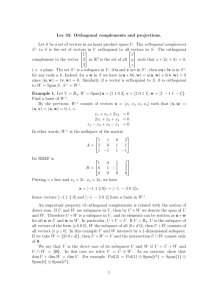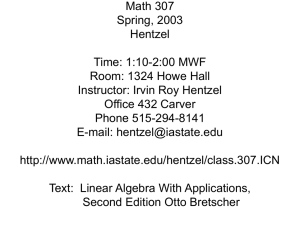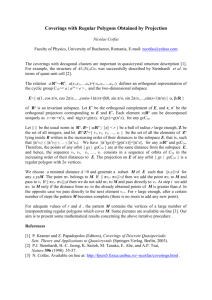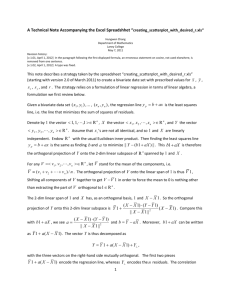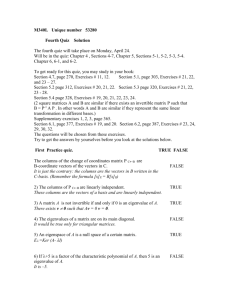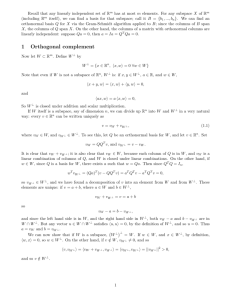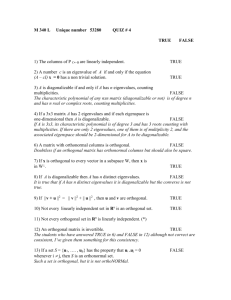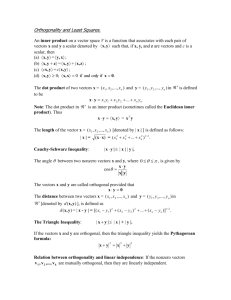Class 26: Gram-Schmidt Orthogonalization
advertisement
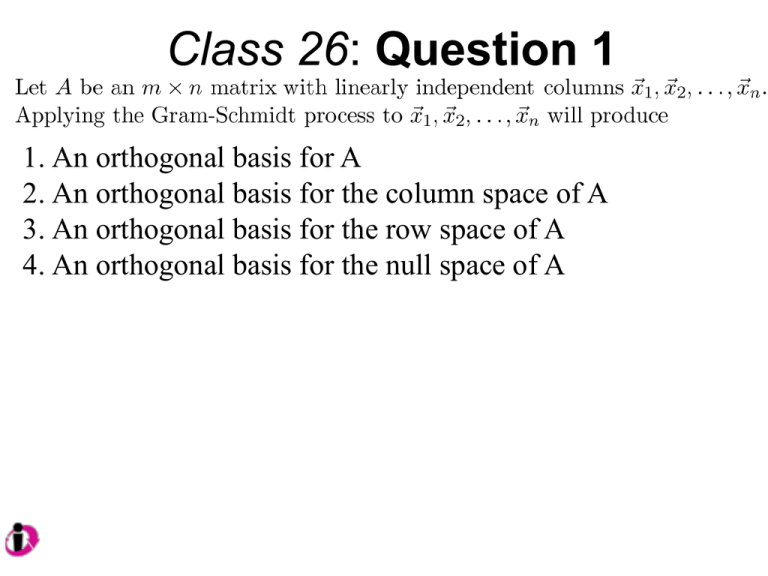
Class 26: Question 1
1. An orthogonal basis for A
2. An orthogonal basis for the column space of A
3. An orthogonal basis for the row space of A
4. An orthogonal basis for the null space of A
Class 26: Answer 1: (B)
The given vectors are n linear independent columns of a
matrix A so they form a basis for the column space of A.
Starting with this basis, Gram-Schmidt Orthogonalization
produces an orthogonal basis which spans the same space
the original collection of vectors does.
Thus the answer is (B), it will span the column space of A
Class 26: Question 2
Class 26: Answer 2: (B)
The way to do this problem is to do one step of GramSchmidt.
Therefore the new pair (-2,1,0) and (3/5,6/5,1) is an
orthogonal set of vectors formed from (-2,1,0) and (1,1,1)
Class 26: Question 3
TRUE or FALSE:
1. TRUE
2. FALSE
Class 26: Answer 3: (A)
Although this second pair of vectors is not formed by
using Gram-Schmidt, it is still an orthogonal pair.
The question is does span{(2,-1,0),(1,1,1)} equal
span{2,-1,0),(3,6,5)}? In other words are they bases for
the same space?
Is (3,6,5) a linear combination of (-2,1,0) and (1,1,1)?
Yes! 5(1,1,1)+(-2,1,0)=(3,6,5).
Another way to see if the spaces are the same is to see if
their cross-product is the same, i.e. they have the same
normal vector, and thus they must lie in the same plane
Class 26: Question 4
TRUE or FALSE: The Gram-Schmidt Orthogonalization
process can be used to construct an orthonormal set of vectors
from an arbitrary set of vectors.
1. TRUE.
2. FALSE.
Class 26: Answer 4: (B)
FALSE! The set of vectors that Gram-Schmidt works on
is not any arbitrary set of vectors, but a linearly
independent set.
Although technically Gram-Schmidt produces an
orthogonal set, one can always continue the process to
the end to produce an orthonormal set.
Class 25: Question 5
1. TRUE.
2. FALSE.
Class 25: Answer 5 (B)
There are multiple bases for R2 so there must be multiple
orthogonal bases for R2. All you need to do is pick two
vectors that are not scalar multiples of each other, are
orthogonal and then normalize them to produce multiple
orthonormal bases in R2. Here are some more
Class 25: Question 6
Let Q be a square matrix with orthonormal columns.
TRUE or FALSE: Q-1=QT.
1. TRUE.
2. FALSE.
Class 25: Answer 6: A
If Q is a square matrix with orthonormal columns then QTQ
must equal the identity matrix.
This is clear because if you multiply a matrix by it’s transpose
then each element of the product consists of dot products of the
rows of the matrix with it’s own columns.
Since the matrix has orthonormal columns those dot products
will produce either 1 or 0, which will result in the identity
matrix. The product has 1 along the diagonal because that is
when a particular column vector is being dotted with itself.
Thus since QTQ=I that must mean that Q-1=QT.
Class 25: Question 7
Class 25: Answer 7 (A)
Class 25: Question 8
Class 25: Answer 8: A
The key thing to understand about this question is that it is the
same question as the one before!
In other words, to make an orthogonal projection onto a
subspace one needs to have a basis for that subspace.
What is a basis for the subspace corresponding to the line
y=x/2? The line corresponds to span{(2,1)}.
Thus (2,1) is a basis for the subspace.
Thus the orthogonal projection of (-3,1) onto (2,1) is (2,1).
Class 25: Question 9
Class 25: Answer 9: D
The line named l is y=3x. This is the subspace span{(1,3)}.
If z is the projection of b onto this subspace it will be some
scalar multiple of (1,3), i.e. (c,3c).
However, the more important part of the problem is the
interpretation of b-z which equals b-projl(b).
Recall that this new vector b-z will be orthogonal to l by
definition.
There’s no way b-z could be a point on l and orthogonal to it.
Thus only two of the statements are true.

